One of Brighton’s quirkiest attractions plans to reopen within days – as staff at the Booth Museum of Natural History, in Dyke Road, dust off the relics.
The Royal Pavilion and Museums Trust said that it was “thrilled” to welcome back visitors from the local community and beyond to see its collections of birds, butterflies, bones and fossils.
With the summer holidays and the easing of coronavirus restrictions under way, the reopening of the child-friendly Booth Museum is likely to be welcomed by parents.
Entrance is free and the museum prides itself on bringing natural history to life with interactive displays and “hands on” activities.
The doors are due to reopen on Saturday (31 July) and the trust that runs it said: “We have been busy cleaning and preparing the galleries for reopening.
“Plus, we have a new display that shows some of the recent big (but tiny) dinosaur discoveries in our collections during the lockdown.
“For the first time, visitors can see a tiny fossil which has excited scientists after they discovered it had been previously mis-identified and is now believed to indicate a new species of pterosaur from the age of the dinosaurs.
“In February 2020, Roy Smith, of Portsmouth University, visited the Booth Museum geological collections.
“He spotted several fossils donated by Arthur Griffith in 1912, identified as shark spines, that he thought were more likely to be pterosaur (flying reptile) bones.
“Roy discovered that the fossils had nerve holes which do not appear on shark spines, so must be from a group of flying reptiles known as ornithostoma.
“He found a fragment of a jawbone of a previously undiscovered flying reptile that was possibly the size of a magpie.
“Unfortunately, this fragment is too small to base a new species on. The rocks it was found in have long since been broken up and it is unlikely more of this specimen will ever be found.
“It remains a tiny tantalising glimpse of life 100 million years ago.”
The trust’s chief executive Hedley Swain said: “It’s wonderful to have the Booth Museum reopen after such a long time.
“This is a fascinating museum which is popular with families and the local community and the final one of our five sites to reopen since the lockdown.
“It’s fascinating to know that the items in the collection, many of which are millions of years old are still relevant to modern experts and improve our knowledge of natural history.”

For more information, including opening times, click here.










